IRENA report features bioenergy supply, demand projections




International Renewable Energy Agency
September 19, 2014
BY Erin Krueger
Advertisement
Advertisement
Related Stories
Clean Energy Technologies Inc. on Oct. 16 announced the Vermont PUC is reviewing a permit application for a proposed 2.2 MW project will use pyrolysis and gasification technologies to convert biomass into renewable synthetic gas for clean combustion.
Carolina Renewable Products, a clean energy company, on Oct. 7 announced it is establishing operations in Orangeburg County, South Carolina. The proposed facility will convert woody biomass into renewable diesel, biochar and wood vinegar.
Exolum invests in UK’s first independent SAF blending facility
European logistics company Exolum on Oct. 15 announced its decision to invest £4.5 million in creating the U.K.’s first independent sustainable aviation fuel (SAF) blending facility at Redcliffe Bay in south-west England.
Erie County, New York, has launched a pilot program that will test renewable diesel in three Department of Public Works vehicles. If the pilot is successful, the county will roll out the program to the entire fleet.
The U.S. Energy Information Administration on Oct. 15 reported that approximately 1.684 million U.S. households used wood as a primary heating source last winter, down 1% when compared to the previous year.





